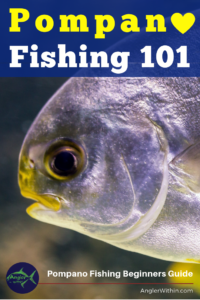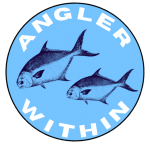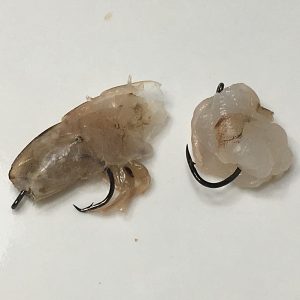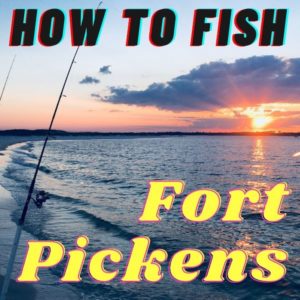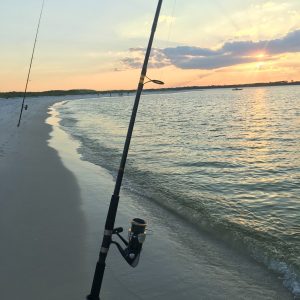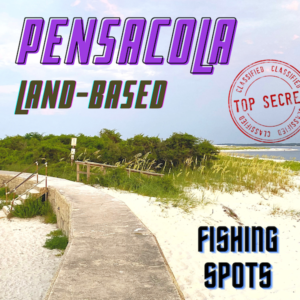anglerwithin.com is a participant in the Amazon Services LLC Associates Program, an affiliate advertising program designed to provide a means for sites to earn advertising fees by advertising and linking to amazon.com.
If you’ve never eaten pompano, you’ve done yourself a disservice. They are one of the best tasting fish in the sea, and their price at the fish market reflects it. However, the lure of the pomp doesn’t end with their taste, as they are also powerful fighters, relative to their size. This makes sense because they are from the jack family of fishes. It’s often said that they are even more powerful than a jack crevalle of the same size. That is certainly saying something!
I’ll break down all aspects of when, where and how to catch them so you can “taste” success when targeting Florida Pompano.
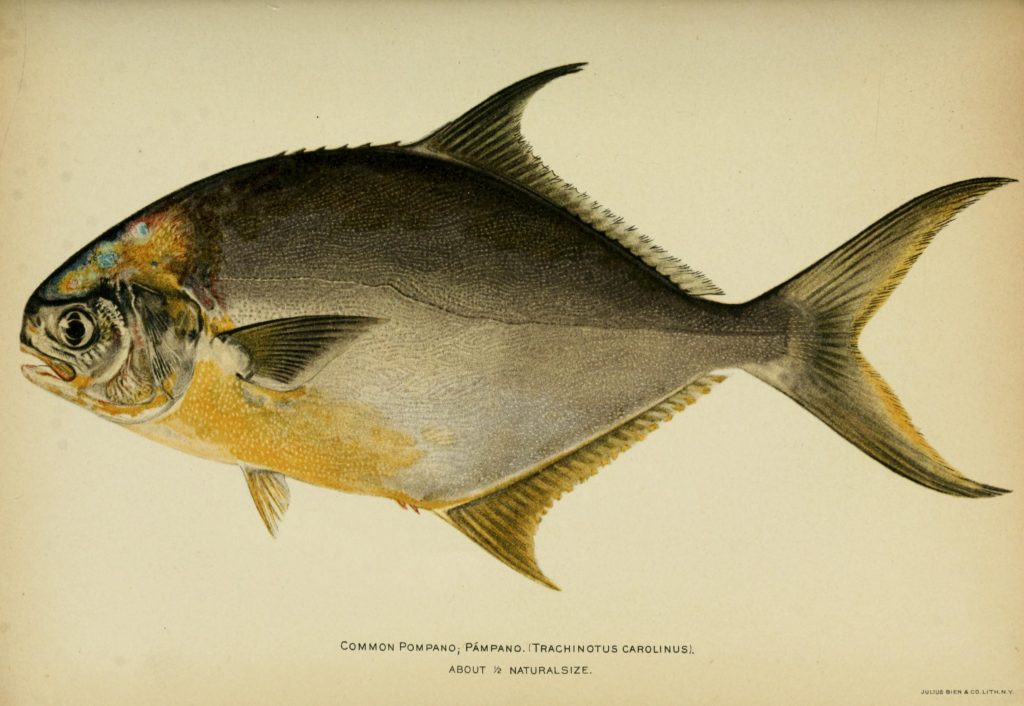
General Info About Pompano
Pompano are a flat, silvery fish with a wide forked tail, which makes for a very powerful swimmer. Their coloration varies between fish, with some being more yellowish on the undersides than others.
The lifespan is commonly only 3 to 4 years. But, they can live longer and grow to over 8 pounds, which would be a giant pompano. They rarely ever get over 4 pounds, and big ones typically fall between 17-25”.
STATE RECORD POMPANO
Note: Record weights may have changed from the numbers posted below, and in fact there seemed to be discrepancies about the largest recorded pompano. But, this gives you an idea of how big pompano get in your area.
- South Carolina - 8 lbs 12 oz
- Louisiana - 8.5 lb
- Florida - 8 lbs 4 oz (***click this link to read about a potential world record pompano caught with Fishbites***)
- North Carolina - 8 lbs
- Alabama - 6 lbs 13 oz
- Texas - 6.4 lbs
- Virginia - 5 lbs 10 oz
- Georgia - 5 lbs 4 oz
- Mississippi - 4 lbs 15 oz
Florida Pompano are primarily a bottom feeding fish, mainly feasting on crustaceans. Their undisputed favorite food is sand fleas (mole crabs). But, they will also feed on all sorts of small crabs, shrimp, and even small fish.

Pompano migrate in schools, heading south in the winter and then back north as the weather warms. Water temps are the name of the game and will dictate where you find pompano. Because of this, the timing of the “pompano run” will obviously vary depending on your location. You will likely experience an influx of pompano in the spring and then again in the fall.
During the right time of year, they are easy to catch and they taste great. Also, while targeting pompano, there is a great likelihood that you will catch other desirable species such as whiting (kingfish) and redfish. For these reasons, pompano are a great fish to target for tourists and beginners.
Although it’s of no use to us surf-bound anglers, one interesting fact about pompano is that they have a tendency to skip out of the water behind a boat’s wake. It’s not known why they do this. This behavior is often used by boating anglers to locate schools of pompano in and near the surf.
Pompano vs Permit
The only fish a pompano would typically be confused with is a juvenile permit. Following are some of the differences between the two in case you happen to run across a permit in the surf. If you memorize just a few of these, you should be able to tell them apart.
Pompano
- Max is around 25"
- Max is around 8 pounds
- Possible yellow underside
- Florida pompano do not have teeth on their tounge
- A pompano's head slopes back gently with no abrupt change in angle - no hump
- Pompano have more rays than a permit; 22 to 27 dorsal rays and 20-23 anal rays
- No dark spot on their pectoral fins
- The beginning of their anal fin starts further back than the beginning of their dorsal fin
Permit
- Max is around 48"
- Max is around 50 pounds
- Possible orange underside
- Pompano sized permit have teeth on their tounge
- Permit have dorsal and anal fins that are longer and drape back toward their tail
- Permit have sort of an appearance of a bump on their forehead, due to the change of angle to the slope of their head
- Sometimes they have a dark spot under their pectoral fins
- Have fewer rays than a pompano. 17 to 21 dorsal rays, and 16 to 19 anal rays
- The beginning of the anal fin is in line with the beginning of the dorsal fin
When To Target Pompano
Pompano are a migrating fish that moves with the changing water temps. So, the timing of their arrival and exit will be dictated by the weather. If the annual cold snaps hit early, then the pompano will show up early and vice versa. The migration follows a north to south direction in the fall . So, if we take Florida for example, the best fishing will start in the very northeast in the fall and gradually move down the coast.
Pompano will generally be on the move as water temps approach 62 degrees. They prefer water temps between 65 and 85 degrees with 68 degrees being the sweet spot. So, find out when the water temps normally hit the desired temperature zone in your area, and then hit the beach.
Generally, the best fishing times in a day will be during tide movement. Incoming tides, and the front of outgoing tides will typically be best.
Besides focusing your efforts around the ideal water temps and tide movements, the next thing to consider is the surf conditions. Ideal surf conditions for pompano are when there is just enough wave action to stir up the sand near the shore, but not so much that it dirties up the water too much. Surf conditions are discussed in more detail below.
Where To Find Pompano
Before you can catch pompano, you first have to find them. The name, “Florida Pompano”, is deceiving as this fish ranges quite a distance beyond the state of Florida. They can be found from Massachusetts all the way around Florida, throughout the gulf, and down towards South America.
You can encounter pompano on the beach, off of ocean-facing piers and even inshore.
One of the greatest things about pompano is that they can be found running fairly close to the beach, and within easy casting range. So, there is no need to fight crowds to claim a prized fishing spot on a jetty or pier. Simply find a nice section of beach, and locate the best area (discussed below) along that stretch, and you should be in business when the pompano are running.
Water Conditions
Neither super clear water nor really stained water are ideal for pompano. It’s best when the surf is slightly active and stirring up the crustaceans on the bottom. However, cleaner water is definitely better than dirty water, and you should generally seek it out. Like most things, there is a sweet spot that offers the best conditions.
If the water is really rough, it might not even be worth trying for pompano, since they might move further out to clearer water and out of reach. There are, of course, “levels” of rough water.
If the water is dingy, you can still catch pompano, but you should probably use a bait that has some smell to it. Fresh shrimp and Fishbites are good options when the surf conditions are rough. Or, you can even put a strip of Fishbites on the same hook as your sandflea in order to soup up your offering.
Look For Something "Different"
For best results, look for areas that are deeper than the surrounding water. This could be deeper holes, or cuts through the sandbar. If you can find a rip current, that’s a great place to encounter pompano and other game fish that are hanging out and feeding on bait being swept offshore.
As the water temps climb later in the summer, you may have to fish further from shore to find pompano in deeper water. This is when a long surf rod comes in handy, so you can probe deep holes and troughs further from the beach.
A good tactic for locating good fishing spots is to go to the beach during low tide and search out deeper (darker) areas. Go back at a higher tide and fish those areas.
There is a great YouTube resource, inserted below, that will teach you how to read the surf . This will help guide you in knowing where to focus your efforts. It’s actually a 3 part series that’s well worth your time if you are lacking skills in this area.
Find The Bait, Find The Fish
If you can find an area of beach that has a lot of small clams (coquina claims) lying around, that is a great spot to start fishing. Additionally, if the stretch of beach has an abundance of sand fleas, then that’s obviously a good sign that you are in the right place. Finding an abundance of bait oftentimes means that you have found the fish.
CREATURE FEATURE: COQUINA CLAMS
— Padre Island N.S. (@PadreIslandNPS) October 17, 2018
Watch as they use their foot (the small appendage coming out of their shell) to dig themselves back into the sand. #beach #waves #padreislandnationalseashore #padreisland #northpadreisland #nps #usinterior #corpuschristi #southtexas #gulfcoast pic.twitter.com/94MCJkpp1A
Gearing Up For Pompano
You really have two ends of a spectrum when it comes to surf fishing gear – a minimalist approach, or one that leans more towards a commercial fisherman. I’ll provide a list for each so that you can cobble together your own list.
Keeping It Light
- One 7-10 foot surf rod
- A 2500-4000 sized reel with 10-20 pound mono
- A bag of Fishbites
- A cup of fresh dead shrimp
- Fishing License
- Measuring Device
- 1/0 Circle Hooks
- Drinking water
- Hat
- Sunglasses
- Collection of pyramid sinkers varying in size
-
Sunscreen
- Knife or Multi-tool (with pliers)
- Tackle bag or bucket to hold your terminal tackle
Getting Serious
- These items are in addition to the "light" list
- Surf cart
- Cooler with ice
- Towel to wipe hands
- Several 9-12 foot surf rods
- Sand flea rake
- Live shrimp
- Several sand spikes
- Rubber mallet to pound sand spikes
- Chair
- Bucket
- Gaff or Fish Grip
- Extra fresh water to rinse any accidentally dunked reels
- Scissors for cutting braid or baits (Fishbites)
Beach Carts
Assuming you aren’t allowed to access the beach with your vehicle, which is the case for many of us, a beach cart is a tremendous luxury. If you can stomach the up front investment, and you have a vehicle (truck) that can transport it, I highly recommend one.
Having a beach cart opens up the opportunity to take a cooler to the beach. It’s very nice to have a decent sized cooler that can serve as your fish box. You’ll want to keep your drinks and snacks separately from your fish. So, I prefer a 2nd small soft sided cooler for that.
Without a beach cart, it’s a nightmare to try to lug a cooler to the waters edge. If you don’t have a cooler, one alternative for keeping your catch fresh is to bury them in sand deep enough to where they will remain moist and cool. Just don’t forget where you buried them!
The best beach carts are those that come with the really big gray balloon tires. Those are really nice, but they are also REALLY expensive. These over-sized tires work especially well on the Florida panhandle, and anywhere the sand is very soft. If balloon tires are not in your budget, that’s OK. A cart like the one pictured below is much more affordable and will work just fine. This is the style I have used in the past, and it’s what I see most people using.

Rods For Pompano
When it comes to rods, I’m usually torn about the issue. On one hand, I really like my long 12 foot rods so that I can really get the bait out there when necessary. But, such large poles mask much of the strength of these spirited little fighters. A lighter setup is much more fun when you hook up. You will have to make your own call as to the preference of your rod(s).
If you plan to target pompano on your vacation, it can be a real pain to try to pack long rods into a small car. No worries, either buy 2 piece rods, or you can even use short rods. When it comes down to it, any rod will work fine for catching pompano. Even a 5 foot medium light rod would suffice most of the time.
Reels For Pompano
I like a 4000-5000 sized reel, but any sized reel will work. I don’t personally prefer the really small reels, because you never know what might pick up your bait at the end of a very long cast. Larger reels hold enough line to have a reserve left to be able to fight a large fish at the end of such a cast.
To be clear, you don’t typically need long casts to catch pompano. But, on occasion, they will be running further offshore, and you will need to cast further out to reach them. A longer rod and adequate reel capacity is the only way you can get the distance sometimes needed.
Line For Pompano
Nothing complicated here. Your line should be 10-20 pound mono, flourocarbon or 20-30 pound braid.
Terminal Tackle For Pompano
When it comes to weights, you want to use the lightest weight that the current will allow. I typically go with a 1 ounce pyramid weight when possible. You will usually need to use between a 1-4 ounce pyramid sinker, so you should have a selection of weights in that range. If the conditions require a heavier weight than that, then it’s not an ideal day to target pompano.
As far as hooks go, I pretty much stick to 1/0 circle hooks. That’s a really good size for pompano, and they are big enough to handle any large bonus fish you might run into, such as bull reds or black drum. 2/0 and #1 circle hooks are fine options as well.
Best Leaders For Pompano
The best leaders for pompano are 2 hook pompano rigs. These can be bought pre-made, or they can be easily hand tied yourself. I prefer to hand tie my own so I can pick exactly what hooks, line, beads, and floats I want. More about pompano rigs later.
The Setup For Pompano
When I’m after pompano, I like to take 3 thin-wall pvc surf spikes and space them 5-7 yards apart. I’ll take a rubber mallet to tap them securely into the sand.
Sand Spikes
You can make your own surf spikes out of pvc from the hardware store, and I have done that. But, I found that I prefer the sand spikes available from Dick’s or Academy Sports that are made a little more lightweight. I try to minimize weight anywhere possible in my beach loadout. To this point, knock on wood, I have caught bull reds and sharks, and they never pulled my lightweight sand spikes out of the sand. You have to remember to keep your drag loosened any time you have a rod in a rod holder.
Multiple Rods
Typically when I’m using multiple rods, I like to have 1 bigger rod with me. I throw this “extra” rod out with a larger bait to target bigger fish, like bull reds. When pompano fishing, you will undoubtedly catch some sort of small non-targeted species. Rather than tossing that little fish back, I’ll put it on a hook and throw it back out on my larger rod.
When fishing with multiple rods, I always use pyramid or sputnik weights to anchor my baits in place. If you don’t use a weight that holds your baits firmly to the bottom, you are going to have a tangled mess on your hands.

Single Rod
There is nothing wrong with using a single rod. If you decide to do so, I would not necessarily use pyramid weights as my first sinker option. As long as the current isn’t too strong, I might use some other style of sinker (bank sinker) that allowed my bait to slowly move along the bottom. This will help you cover ground more quickly and find where the fish are holding. If the current is moving your offering along too fast, I would change back to the tried and true pyramid weight.
Pompano Rigs
I prefer to use 2-hook pompano (high-low) rigs similar to my image below. I typically tie my own so I can get them just like I want. If you don’t wish to tie your own, these Sea Strike 2 hook rigs on amazon look pretty good – Sea Strike PPR20 2-Hook Pompano Rig. They are made with circle hooks, which is my preference. I’m not particularly fond of the kahle hooks that come on most pompano rigs.
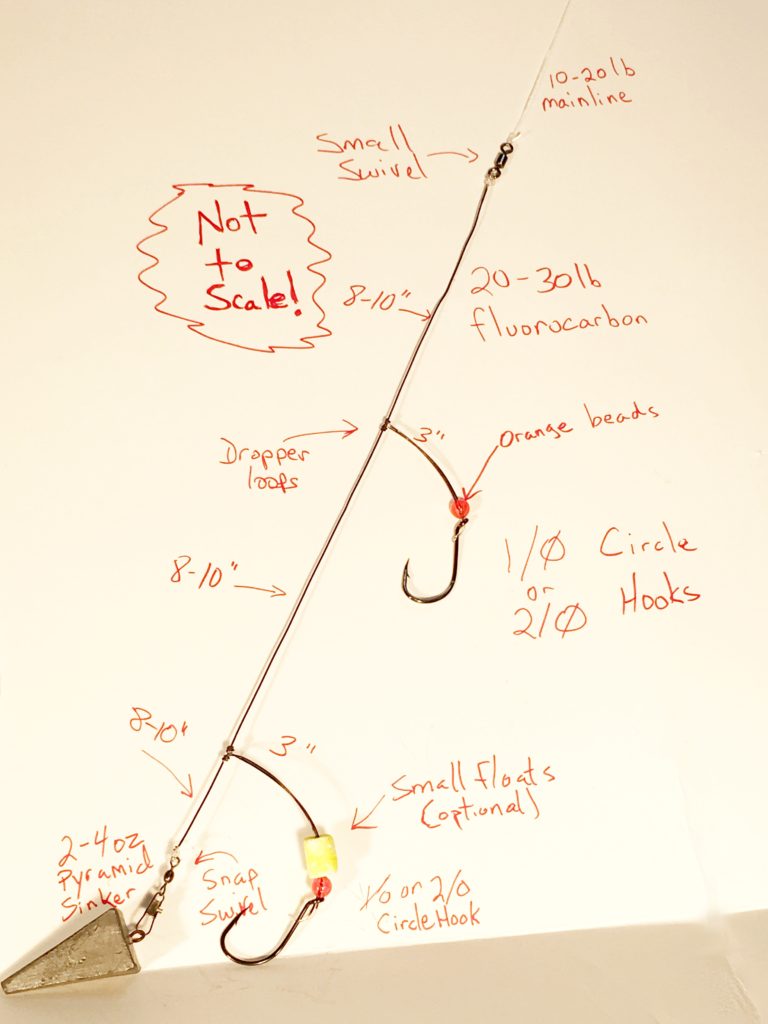
A 2 hook rig serves several purposes. Not only do they increase your odds by having more baits in the water at the same time, they also help you to more quickly dial into what the fish prefer on a given day.
By placing different baits and different colored beads and floats on each hook, you can eliminate less preferred options quickly. For these reasons, I prefer to tie my own pompano rigs. Tying your own gives you great flexibility in choosing your own hook size, bead color and whether to use floats or not.
Sometimes I use beads, sometimes I don’t. The same goes for floats. In very clear water, pompano can sometimes be particular about hitting your rig, so I might further downsize my tackle to have no beads or floats at all.
Advantages To 2 Hook Rigs
- Multiple baits increase your odds of success
- Lets you cover different depths of the water column
- Opportunity to try different colors of floats and beads at the same time
- You have an extra bait in case you sling one off during the cast
- Lets you use different baits at the same time to more quickly find what the fish prefer
- Allows you the occasional opportunity to catch 2 fish at once
Unlike some of the species we target in the surf, pompano are adept at spotting different colors, so use that to your advantage. It is common that pompano rigs are tied using colored floats and beads, most commonly orange. But, other colors can also be productive. The reason orange is so prevalent is that it mimics the orange eggs found on the underside of some sand fleas. You could instead try to match the prevalent color of any coquina clams you see on the beach. Pompano might be honed in on a different color for the day. If you have multiple rods, you will want to experiment to see what colors might work better on a particular day.
Baits For Pompano
I have an entire article about all the baits that can be used for pompano, if you are interested: The Best Baits For Pompano
Best Baits For Pompano
- Sand Fleas (Mole Crabs)
- Live Shrimp
- Ghost Shrimp
- Fresh Clams
- Fiddler Crabs
- Fresh Dead Shrimp
- Fishbites (one of my favorites!)
- Goofy Jigs (Banana Jigs)
- NyLure Pompano Jigs
Other Baits For Pompano
- Other Small (legal) Crabs
- Salted Clams
- Frozen Shrimp
- Cut Squid
- Crappie Jigs
- Artificial Flies (For Fly Fishing)
- Bucktail jigs
- Soft Plastics
- Frozen (and blanched) Sand Fleas
Most of the time, sand fleas are unquestionably the best bait for pompano. There are other baits that will work great as well, but if you are able to obtain live sand fleas on a given day, that’s what you should use. Other very productive baits are small shrimp, and Fishbites. These are the 3 baits I’ll focus on below. If you want more info about other bait options for pompano, you can refer to my article here: Best Baits For Pompano.
Sandfleas - Where To Find Them
You will find sand fleas where the waves are lapping onto the beach (the “swash zone”). With practice, you can spot them before you even bother to scoop. Their small antennae make tiny V’s in the sand as the water recedes. If there is a large colony around, there will be an obvious discoloration in the sand as the waves roll back over them.
Sandfleas - How To Catch Them
There are many ways you could catch sand fleas. The simplest way is to scoop them out with your bare hands. But, that is a pretty inefficient method and plays hell on your back. I honestly would recommend that you break down and invest in a sand flea rake. Nothing is more efficient and easier to use than a proper rake.
The cheapest sandflea rakes I’ve seen were at local wally worlds near the beach. And, those work just fine. However, you can certainly find better and similarly priced rakes online (Amazon) or in local tackle shops. But, even the cheapest rakes are much better than non-rake alternatives. Below is the sandflea rake that I have, which I purchased from Amazon. You could go bigger, but I try to minimize the weight of my beach gear whenever possible. That is why I chose this one over the larger size.
Some of the other alternatives are, scooping them with cheap metal collanders, toy plastic shovels, or buckets with holes drilled in the bottom. The possibilities are endless. But the back pain won’t be – trust me. Get a rake.
The YouTube video below is the best one I have found that shows you how to catch sand fleas.
Sandfleas - Storing Them
You have a couple options in how you manage your mole crabs after you catch them. If the weather is warm, and I’m wearing swim trunks, I might simply make a scoop with my rake, and place a handful in the pocket of my swim trunks. I’ll pull one out as needed, and when I run out, I’ll make another scoop.
Other times, I’ll rake up my entire supply for the day and store them in a container near my setup. If you go this route, you do have to take care so that you don’t kill your hoard of fleas. If you were to just throw them into a bucket of water, the accumulation of their urine, over the course of time, will kill them. This will happen quicker than you might imagine. Instead, you should store them in 2 or 3” of damp sand, which will actually keep them alive for several days, if they don’t get too hot.
Another option, which I have used before, is to take 2 plastic containers that nest together. Stack the two containers together with a sea shell or rock between the two containers to create a small space between them. Then, poke holes in the bottom of the upper container so that any urine from the fleas can flow through the holes and away from the crabs. This method will also keep them lively for quite a while.
Sandfleas - Hooking Them
I like to hook a sand flea by holding their digger claw against their body and piercing the hook through it and out the top of the back. This gives your hook two firm surfaces to hold on to, and this minimizes how often you throw the bait off the hook. Be careful not to bust out the shell when working your hook through. If you do so, the bait won’t stay on the hook very well.
Shrimp
In addition to using sand fleas, I usually take fresh dead shrimp as a second backup option. The key here is it being “fresh”. Don’t buy frozen shrimp that you see in local convenience stores. Instead, go to the bait shop and ask for fresh dead shrimp, or buy some from a local supermarket.
Small, live shrimp would be better, but I’m not usually up to the task of carrying a bucket of water and keeping them alive. If you plan to use a surf cart, live shrimp is a great option. When using live shrimp, you want to use the smallest ones you can find. When using dead shrimp, break them in half, or about the size that will cover a 1/0 circle hook. Some people even go so far as to peel their shrimp before placing them on a hook. I usually only do that when targeting whiting.
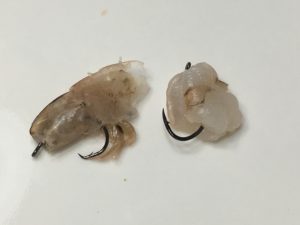
Fishbites
One bait I always take with me to the beach is Fishbites. For me, no other bait has proven to have a better combination of being both convenient, and effective for pompano. You can just stick a pack in your tackle bag, for use when you either run out of bait, or you can’t find sand fleas.
Fishbites also work well when combined with natural bait on the same hook.
I have, in fact, taken ONLY Fishbites to the beach before and easily limited out on pompano. So, I know they work very well.
Another added benefit is that, because of the thin mesh material found inside Fishbites, they stay on a hook very well, even through multiple caught fish.
My favorites are the orange sand flea flavor, and the pink shrimp flavor. These are the ones, available from Amazon, that I use most often: Fishbites Strips in Sandflea (15 Ct)
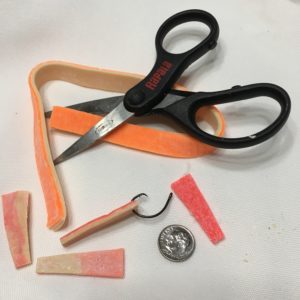
These are the pink shrimp flavor Fishbites I like to have, in addition to the orange sand flea ones.
How To Actually Catch Pompano
Where To Put Your Bait
Early in the morning, or late in the evening, just toss your baits in the first trough off the beach. That’s where you want to try first. If you can’t find success there, then you can start casting further out. As the sun comes up, the fish may move further off the beach to deeper water. That’s when your long rod and heavy pyramid sinker come into play.
When casting out your baits, you will typically only want to let it sit for 5-15 minutes, depending on how good the bite is that day. By that time you may have missed the bite, or crabs could have stolen your bait, so it’s time to reel in and check the situation.
Hooking And Landing Pompano
Since I typically only use circle hooks, I don’t “set the hook”. Instead, you just start reeling and apply firm pressure to place the hook in the corner of the fish’s mouth.
You can expect a hooked pompano to make a parallel run along the beach once you get him near the surf line. That’s a tell tale sign that you have a pompano on the end of your line.
Rather than forcing the fish through the breaking waves, time your retrieve to let a rolling wave surf the hooked pompano onto the sand. If you do this, there is much less pressure needed to land the fish, and thus less of a chance of pulling the hook free.
Conclusion
One of my favorite things about fishing for pompano, whiting and other beach dwelling fish is just that – they can be caught from the beach. I like fishing from a boat or kayak as much as the next guy, but there is something special about pursuing a favorite pastime, and doing so while on a beautiful beach. There aren’t many places I’d rather be.
If you found this article helpful, please share it on your social media accounts. I would really appreciate it. Thanks!
Good luck out there,
Augustus
